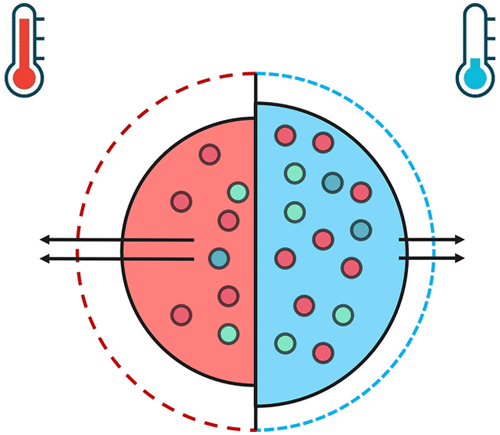当前位置:
X-MOL 学术
›
ACS Earth Space Chem.
›
论文详情
Our official English website, www.x-mol.net, welcomes your
feedback! (Note: you will need to create a separate account there.)
Effect of Decreased Temperature on the Evaporation of α-Pinene Secondary Organic Aerosol Particles
ACS Earth and Space Chemistry ( IF 2.9 ) Pub Date : 2019-11-22 , DOI: 10.1021/acsearthspacechem.9b00240 Zijun Li 1 , Olli-Pekka Tikkanen 1 , Angela Buchholz 1 , Liqing Hao 1 , Eetu Kari 1 , Taina Yli-Juuti 1 , Annele Virtanen 1
ACS Earth and Space Chemistry ( IF 2.9 ) Pub Date : 2019-11-22 , DOI: 10.1021/acsearthspacechem.9b00240 Zijun Li 1 , Olli-Pekka Tikkanen 1 , Angela Buchholz 1 , Liqing Hao 1 , Eetu Kari 1 , Taina Yli-Juuti 1 , Annele Virtanen 1
Affiliation

|
The interplay of volatility distribution and particle viscosity governs the gas-to-particle partitioning dynamics of atmospheric secondary organic aerosol (SOA) constituents. Temperature-induced shifts in both particle volatility distribution and viscosity can influence the evaporation behavior of atmospheric SOA particles. However, knowledge of particle evaporation at low temperatures is still limited. Here, we combined isothermal evaporation measurements and process modeling to explore the evaporation of α-pinene ozonolysis (αpinO3) and photo-oxidation (αpinOH) SOA particles under a series of relative humidities (RHs) at two different temperatures. Experimental results revealed that the particle evaporation was hindered at low temperature in agreement with the temperature dependence of the effective saturation vapor concentration and the possible temperature impact on the particle viscosity. Both αpinO3 and αpinOH SOA particles showed similar evaporation rates at 80% RH when particles were in a liquid state. However, they showed different evaporation behaviors when present in a semi-solid phase state at low RH. Furthermore, using the evaporation measurement data in model simulations, we could derive particle volatility distributions, enthalpies of vaporization, and composition-dependent viscosities for both the investigated SOA systems. The observed particle size change was well reproduced by process models using the fitted particle volatility distribution and viscosity. Although the observed evaporation rate of α-pinene SOA particles at an intermediate RH is similar to high RH (80% RH), the simulation results showed that the evaporation of organic compounds from viscous particles shifts from a liquid-like process at the initial stage to a kinetic-limited one at the later stage of evaporation.
中文翻译:

温度降低对α-P烯次级有机气溶胶颗粒蒸发的影响
挥发性分布和颗粒粘度之间的相互作用决定着大气中次级有机气溶胶(SOA)成分的气体-颗粒分配动力学。温度引起的颗粒挥发度分布和粘度变化会影响大气SOA颗粒的蒸发行为。但是,在低温下颗粒蒸发的知识仍然有限。在这里,我们结合等温蒸发的测量和建模过程,探讨α蒎烯臭氧分解的蒸发(αpinO 3)和光氧化(αpinOH)SOA颗粒在两个不同温度下的一系列相对湿度(RHs)下。实验结果表明,与有效饱和蒸汽浓度的温度依赖性以及温度对颗粒粘度的影响有关,在低温下阻碍了颗粒的蒸发。无论αpinO 3当颗粒处于液态时,αpinOHSOA颗粒在80%RH时显示出相似的蒸发速率。但是,当在低RH下以半固相状态存在时,它们表现出不同的蒸发行为。此外,使用模型模拟中的蒸发测量数据,我们可以得出两个SOA系统的颗粒挥发性分布,蒸发焓以及与组分有关的粘度。使用拟合的颗粒挥发性分布和粘度,通过过程模型可以很好地再现观察到的粒径变化。尽管在中等RH下观察到的α-pine烯SOA颗粒的蒸发速率与高RH(80%RH)相似,
更新日期:2019-11-22
中文翻译:

温度降低对α-P烯次级有机气溶胶颗粒蒸发的影响
挥发性分布和颗粒粘度之间的相互作用决定着大气中次级有机气溶胶(SOA)成分的气体-颗粒分配动力学。温度引起的颗粒挥发度分布和粘度变化会影响大气SOA颗粒的蒸发行为。但是,在低温下颗粒蒸发的知识仍然有限。在这里,我们结合等温蒸发的测量和建模过程,探讨α蒎烯臭氧分解的蒸发(αpinO 3)和光氧化(αpinOH)SOA颗粒在两个不同温度下的一系列相对湿度(RHs)下。实验结果表明,与有效饱和蒸汽浓度的温度依赖性以及温度对颗粒粘度的影响有关,在低温下阻碍了颗粒的蒸发。无论αpinO 3当颗粒处于液态时,αpinOHSOA颗粒在80%RH时显示出相似的蒸发速率。但是,当在低RH下以半固相状态存在时,它们表现出不同的蒸发行为。此外,使用模型模拟中的蒸发测量数据,我们可以得出两个SOA系统的颗粒挥发性分布,蒸发焓以及与组分有关的粘度。使用拟合的颗粒挥发性分布和粘度,通过过程模型可以很好地再现观察到的粒径变化。尽管在中等RH下观察到的α-pine烯SOA颗粒的蒸发速率与高RH(80%RH)相似,











































 京公网安备 11010802027423号
京公网安备 11010802027423号